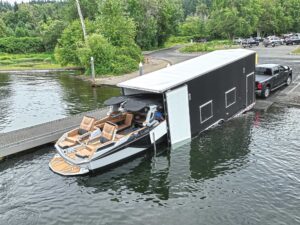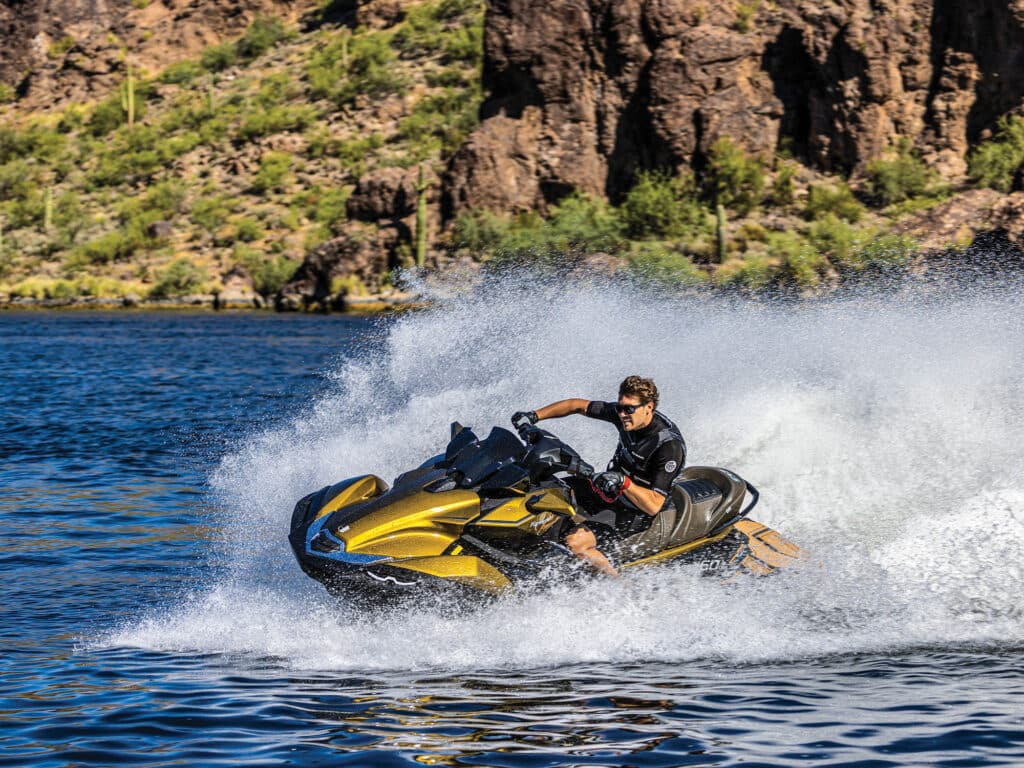
Overview
Kawasaki may have been slow to embrace modern trends like electronic reverse and deceleration systems, or even significantly update its Jet Ski lineup over the last decade, but change is in the wind. First came the midrange STX 160. The following year, a significantly upgraded Ultra 310LX flagship was introduced. For 2023, the company borrows a little of both craft to create the Ultra 160LX, which boasts virtually all the cool style and tech introduced on the 310LX last year, but with the STX’s tamer, supercharger-less engine below the saddle. The result is a premium-level machine that comes in at a far more affordable price while offering greatly increased range.
Both the 310LX and 160LX are based on Kawasaki’s Ultra hull platform, a deep-V design with 22.5 degrees of deadrise that excels in rough conditions, making it a favorite for big-water enthusiasts and offshore racers alike. Over the course of Kawasaki’s nearly 120-mile press ride on the Sacramento River, I noted the craft boasts that same confidence in the confused, washing-machine chop that often plagues group rides. With the throttle pinned, I felt confident charging across mixing wakes, the Ultra staying planted to the water without getting caught up in wakes or wandering. It strutted in glassier conditions, carving turns with razorlike precision with nary a skip or slide.
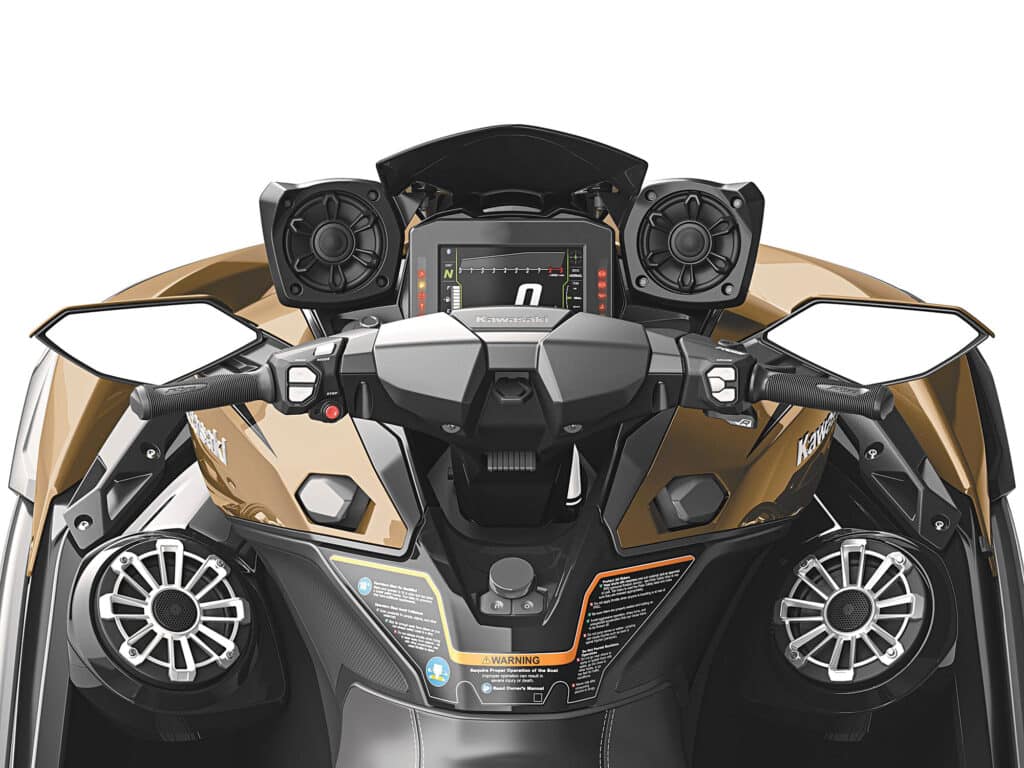
Engine
While riders familiar with the hull would expect that flagship ride, they might not expect great performance. This non-supercharged version of Kawasaki’s 1,498 cc inline, dual overhead-cam four-cylinder offers nearly half the horsepower of its flagship brethren. Still, I found its power delivery impressive for the category. The craft accelerated strong enough out of the hole to please aggressive riders or tow water toys with ease, and it delivered a welcome midrange punch. That overall performance and snappy feel make it somewhat of a surprise when you see the speedometer topping out around the 52 mph mark. Competitive craft typically run 57 to 63 mph.
Extras and Accessories
The 160LX is almost indistinguishable from the 310. It shares the same broad bow, sculpted lines, and ebony and metallic-gold paint job. The 160 also shares the 310’s unique LED accent lights. They’re for style points, not nighttime operation, but they do slightly enhance daytime visibility. Take a seat atop the tiered saddle and two different pairs of speakers catch the eye and the ear. Kawasaki’s 200-watt Jetsound 4S audio system takes PWC sound systems to the next level with 35-watt speakers mounted to each side of the display and 60-watt speakers placed at the front of the footwells. Linked via Bluetooth to a rider’s smartphone, the system produces exceptional sound. A volume dial is to the left of the 7-inch color TFT information display. A phone or other audio source can be placed in a waterproof housing inside the 160’s twin gull-wing storage compartments. The outward-opening doors to port and starboard of the console replace a conventional glove box and are ideal for smaller items riders want to keep within reach, like sunscreen or a water bottle.
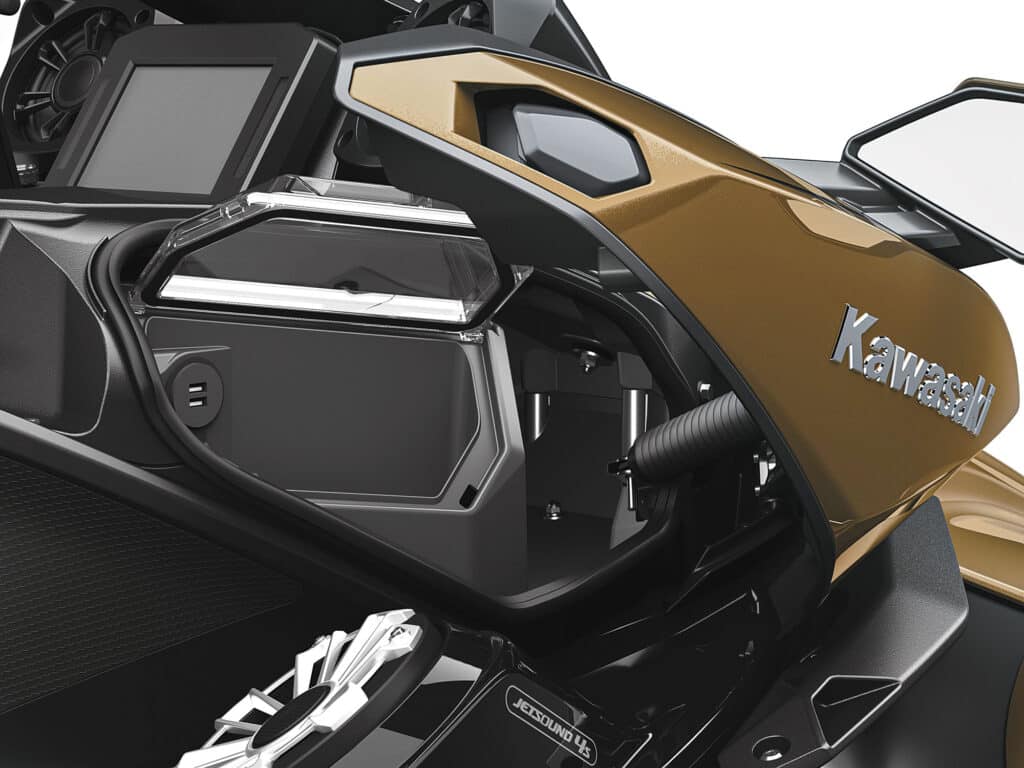
As to additional technology, the most practical addition is Kawasaki Smart Reverse with Deceleration (KSRD), the company’s long-awaited answer to competitive solutions like Sea-Doo’s Intelligent Brake & Reverse and Yamaha’s RiDE system. Though the basic operation is similar to competitors—a curved bucket redirects the flow of water exiting the jet pump to mimic the feeling of forward, neutral and reverse while providing rapid deceleration at speed—Kawasaki eschews a reverse/deceleration lever on the left side of the handlebars in favor of a small thumb lever below the right handgrip. Use the conventional throttle to go forward, then tap the KSRD lever to put the craft into neutral. Apply continual pressure on the thumb lever and you get increasing throttle in reverse. Yes, it’s different than competitive solutions. Out of habit, I reached for a phantom neutral/reverse lever on the left side of the handlebars. But once you get used to the placement, it’s intuitive to use, simple to reach, and keeps eyes on the water, all ideal when backing out of a launch area or maneuvering in a marina’s tight confines.
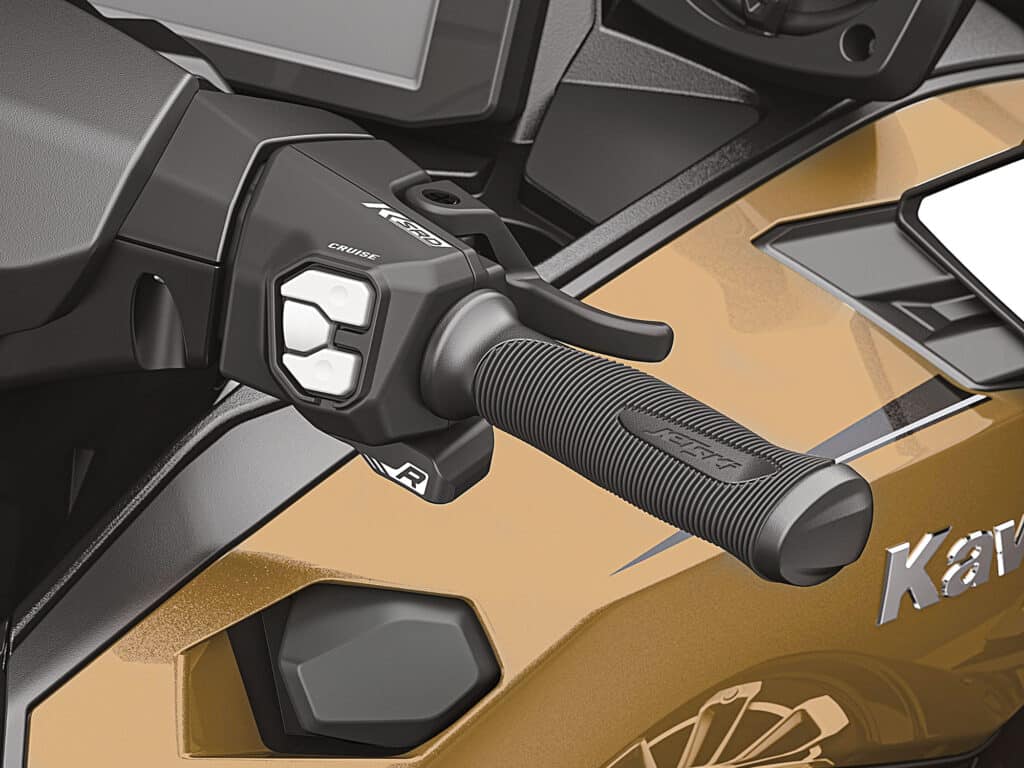
Those latter scenarios also benefit from a first on a personal watercraft: a rearview camera monitored on the dash display. What I first dismissed as almost a gimmick was quickly appreciated while backing up in tight quarters during gas and lunch stops. Surprisingly, I also found having it active while running forward was a good way to check traffic following closely behind before making a turn during our crowded press run. Just keep in mind that the view diminishes as speed increases due to increased water spray coming off the hull. Other tech of note includes an auto trim control, cruise and no-wake modes, and a trio of power-delivery options.
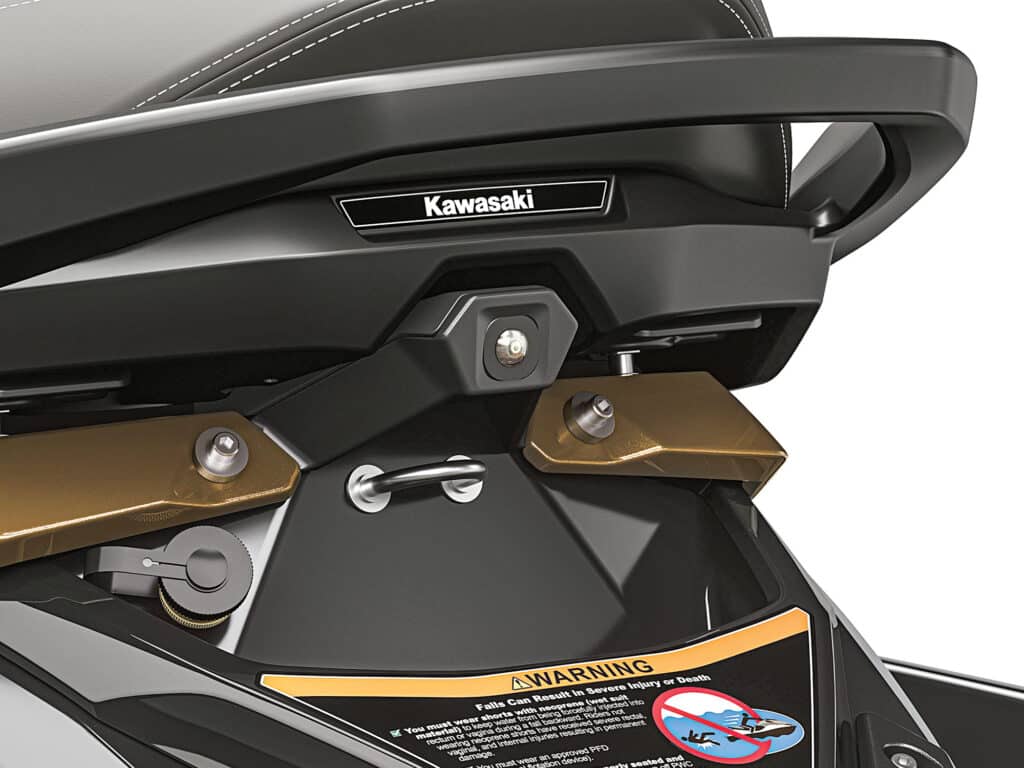
As to how the Ultra 160LX compares to the competition, the toughest bang-for-the-buck competitor would likely be Sea-Doo’s GTX 170. Offering about 5 mph more in top speed, unique cargo storage, and a comfy touring saddle, buyers can option it to include a 100-watt sound system for $15,229. Yamaha’s FX Cruiser HO ($16,699) features an additional jump in performance, a two-speaker Bluetooth sound system, a 5-inch color touchscreen display with GPS mapping and smartphone connectivity, and a glove box with USB and 12-volt charging outlets. Kawasaki, however, has leveled the PWC playing field. The tech zero is now the tech hero.
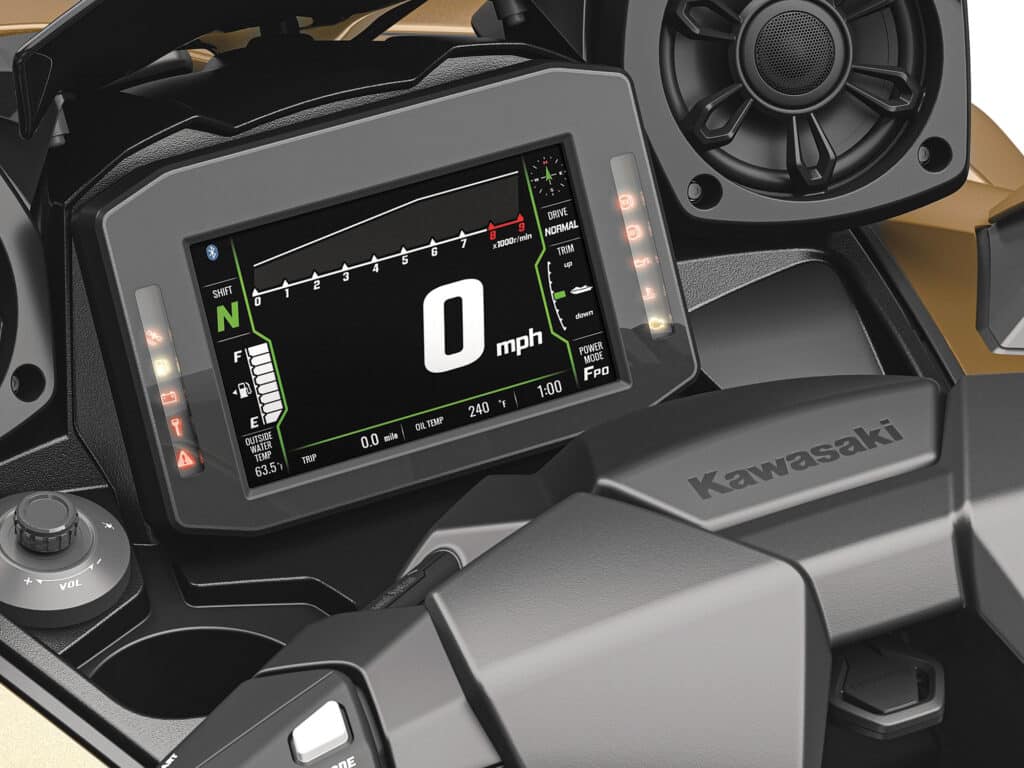
How We Tested
- Engine: 1,498 cc Kawasaki inline DOHC four-stroke
- Pump/Impeller: 155 mm axial flow single-stage jet pump/3-blade, stainless-steel 8-18-pitch oval edge impeller
- Gear Ratio: 1:00:1 Fuel Load: 20 gal. Crew Weight: 155 lb.
High Points
- Launch Control mode matches the trim angle to speed for the best acceleration and overall performance.
- Phone compartment in the starboard gull-wing storage complements a USB outlet to keep electronics charged.
- Track system on the aft platform allows for mounting various accessories, including a cooler and fuel caddies.
Low Points
- KSRD slightly lags, particularly when transitioning from reverse to forward.
- Console storage access is awkward, and some stowed items can slide out of reach.
- Cooler or storage options for the aft platform are welcome, but adding them can block the rearview camera lens.
Pricing and Specs
| Price: | $17,299 |
| LOA: | 140.9″ |
| Beam: | 3’11” |
| Draft (max): | Not much |
| Displacement (curb weight): | 987.8 lb. |
| Bridge Clearance: | 48.8″ |
| Fuel Capacity: | 21.1 gal. |
| Passenger/Weight Capacity: | 3/496 lb. |
| Stowage Capacity: | 44.5 gal. |
| Max Horsepower: | 160 |
| Available Power: | 160 hp |
Speed, Efficiency, Operation

Kawasaki Motors Corp, USA – Santa Ana, California; kawasaki.com

